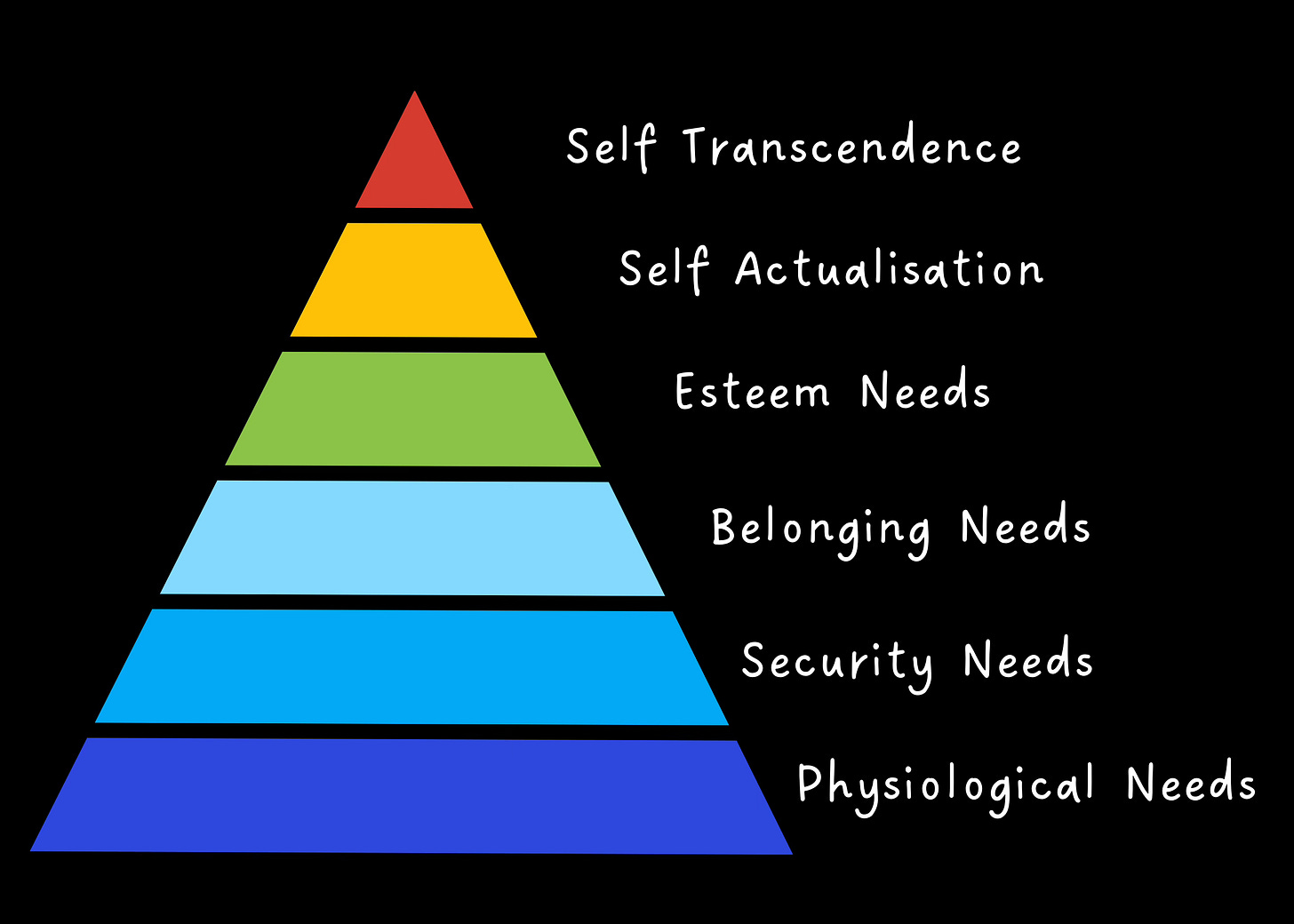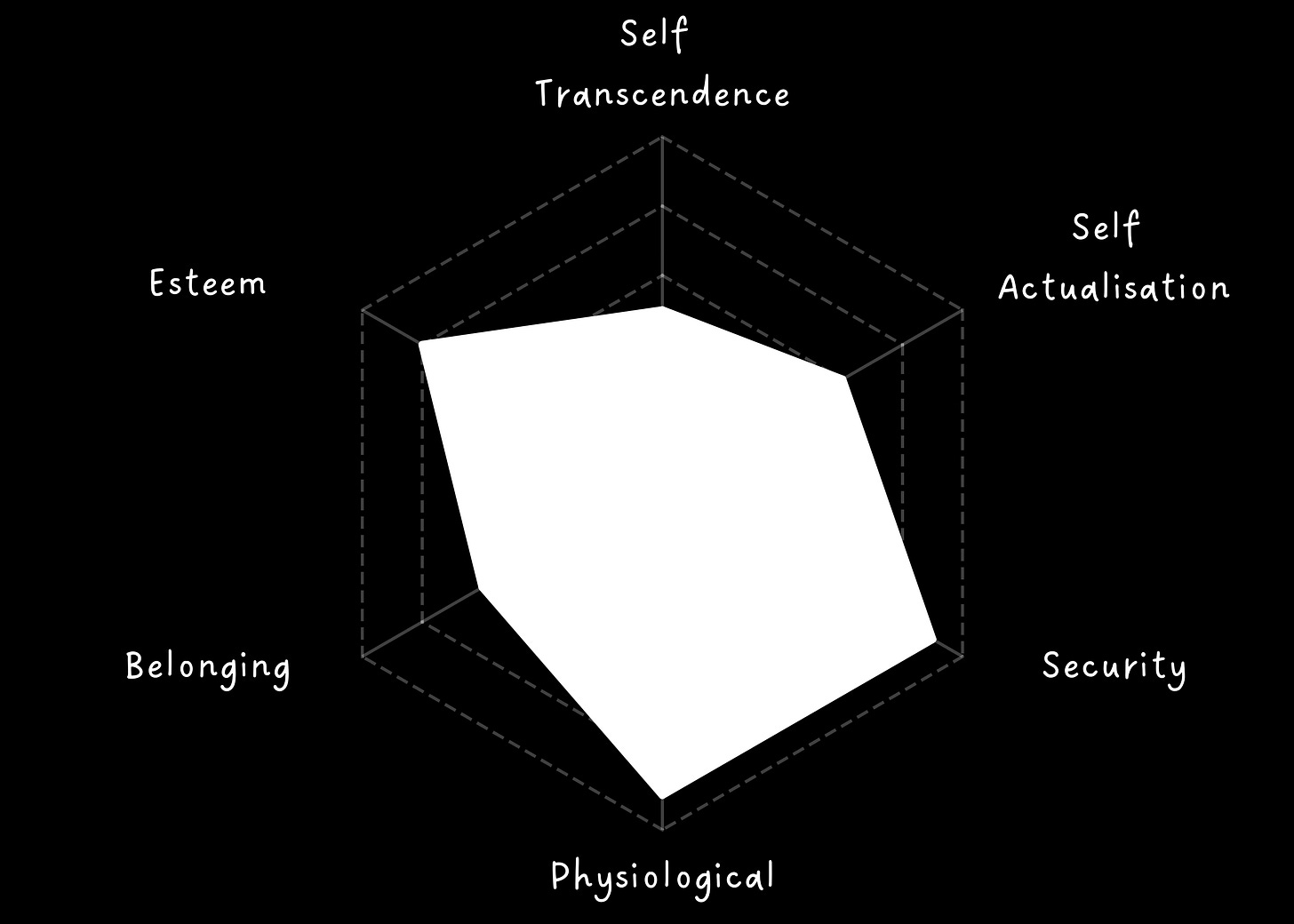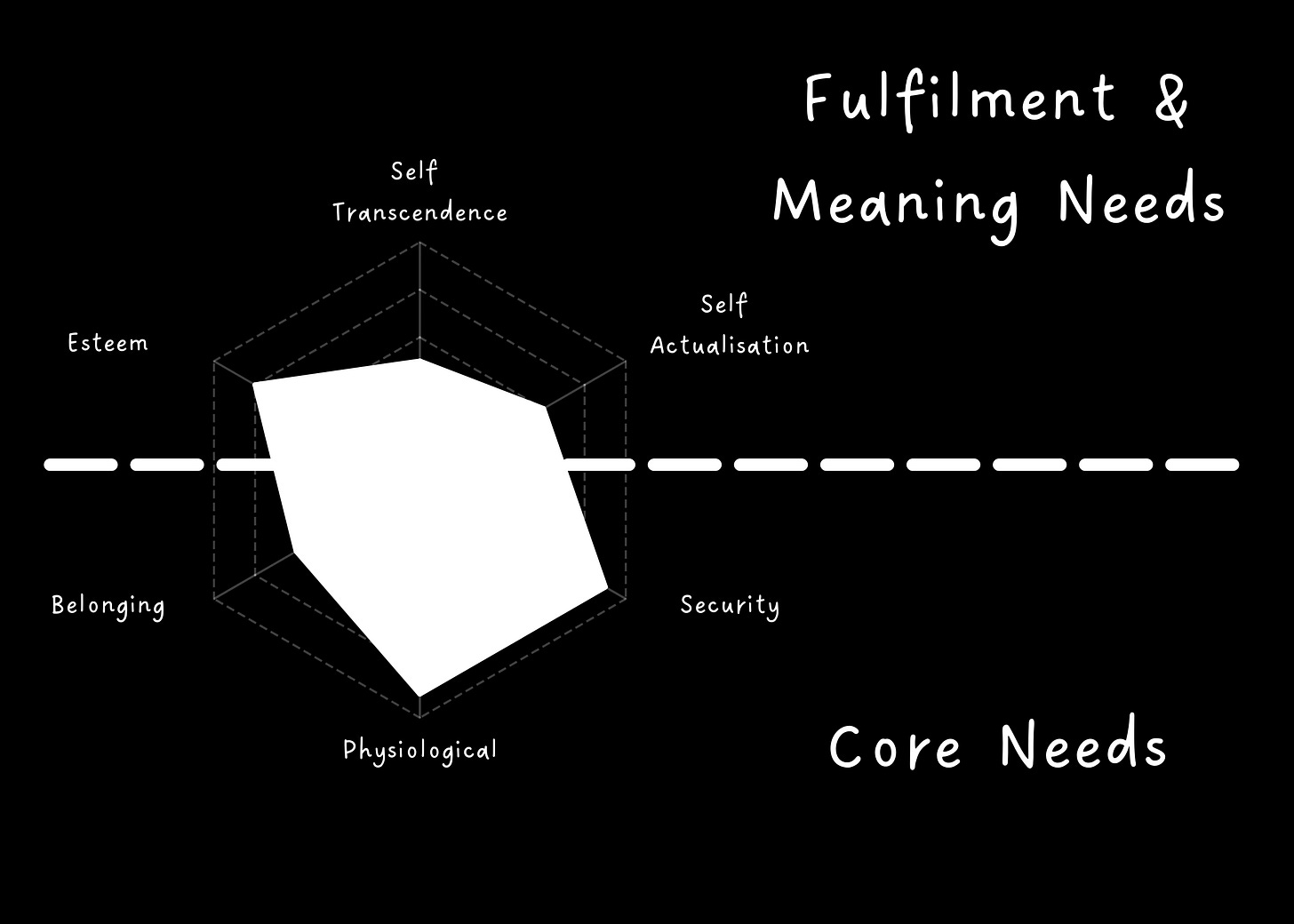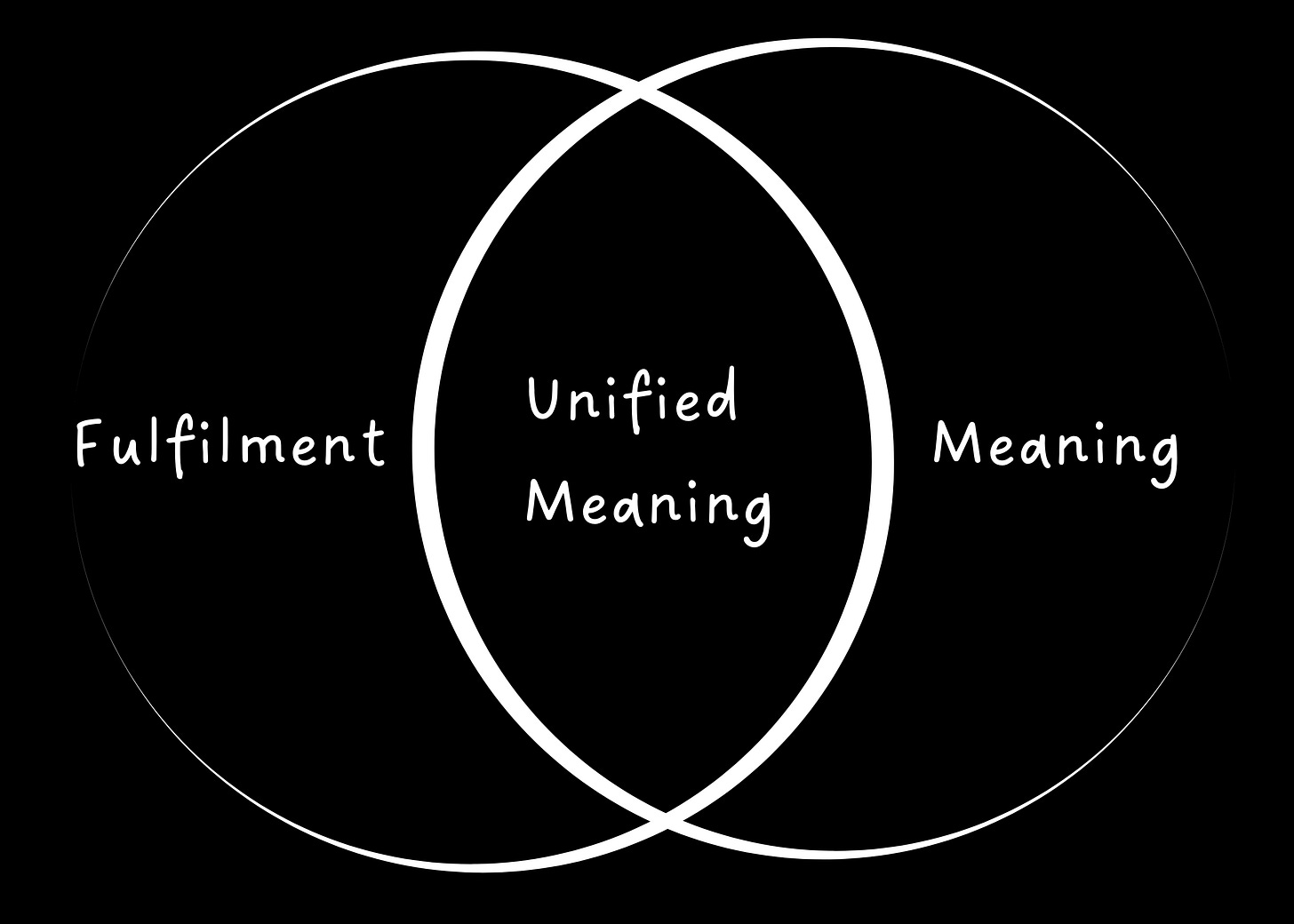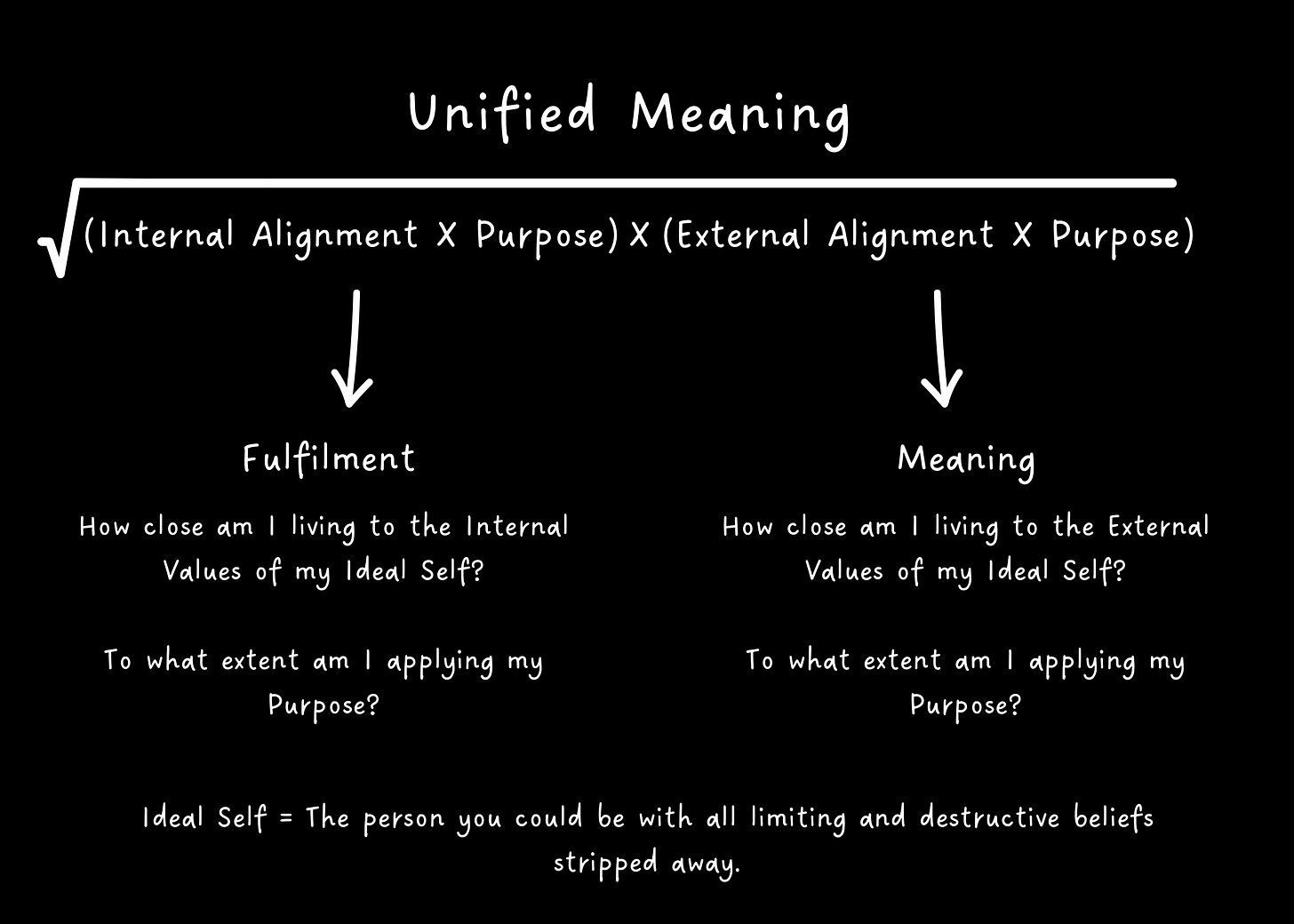Unified Meaning Theory: A New Answer to Life’s Oldest Question
For centuries, philosophers, psychologists, and theologians have searched for the nature of meaning. This theory finally puts the pieces together.
You’ve chased success. You’ve tasted happiness. You’ve done everything you were told would make life fulfilling.
And yet, when you’re alone, staring at the ceiling at 2 AM, the silence is deafening.
What if meaning isn’t something life gives you—but something you have to build?
In This Article, You’ll Learn:
Why traditional meaning models fail.
How Maslow’s pyramid gets human needs wrong.
The equation that measures fulfilment & meaning.
How to measure & increase fulfilment & meaning in your life today.
By the end of this article, I promise that you will not only have a foundational understanding of the true nature of purpose, fulfilment and meaning - you’ll also leave with a simple equation and toolkit that will allow you to create more fulfilment and meaning in your life than you ever thought possible.
A tall order, and a big promise - I know.
But follow along, and it’ll make sense.
Don’t have time right now?
Subscribe to return later.
First, it’s important to define some simple terms to give context for everything to follow:
Love - The resources available to direct toward enabling the growth of something or someone.
Purpose - Love applied in a direction.
Fulfilment - The sense of personal satisfaction acquired from using our purpose in a way that benefits us and furthers our self-esteem and hones our talents/skills.
Meaning - The sense of personal satisfaction acquired from using our purpose in a way that benefits the world in some way.
Ideal Self - The person you could be with all limiting and destructive beliefs stripped away.
Values - The ideals that determine how you think you should be (internal values), and how you think the world should be (external values).
Internal Alignment - How well you direct your purpose in line with the internal values of your Ideal Self.
External Alignment - How well you direct your purpose in line with the values of your Ideal Self.
Now that we’ve got that out of the way, let’s dive in - and if anything doesn’t quite make sense yet, don’t worry; it will soon.
Some of you may be familiar with Maslow’s hierarchy of needs, but for those who aren’t:
“Maslow's hierarchy of needs theory is a psychological concept that proposes humans are motivated by fulfilling a hierarchy of needs, starting with basic physiological needs like food and water, progressing to safety needs, then social needs, esteem needs, self-actualisation and finally self-transcendence at the top level, meaning reaching one's full potential; essentially, lower needs must be met before moving on to higher needs in the hierarchy.”
You may have seen it represented like this:
The problem with Maslow’s original hierarchy is that it presents human needs as sequential; first physiological, then security, then belonging, etc.
But we know humans don’t operate this way.
Think of the soldier on the battlefield - sacrificing security and perhaps even their life to fight for a cause greater than themselves.
The focused creative - working in isolation, foregoing food and sleep in order to build and manifest their talents in the form of art, poetry or literature.
The committed activist - engaging in hunger strikes or putting themselves in harms way to draw attention to a cause greater than themselves.
Even the struggling parent - missing sleep, meals, or foregoing their passions to make sure their children want for nothing.
Or a famous example - Tank Man, the unknown man who stood in front of a column of T59 Tanks in Tiananmen Square in 1989, placing the ideals of justice and truth above his own life - in the wake of the Tiananmen Square massacre, in defiance of the authoritarian Chinese Communist Party.
If we look at human needs as a tiered pyramid, Maslow’s hierarchy falls apart - people very frequently sacrifice lower-tier needs for higher ones.
So, I propose a slightly different model; needs as a spectrum, not a pyramid:
This isn’t a departure from mainstream thought, it’s long been argued by psychologists and academics that Maslow’s original hierarchy failed to capture the dynamic nature of the human experience.
Does this resonate with you?
Do you see yourself as a static, tier-based individual?
Or are you a dynamic, ever-changing individual?
Now, you might be thinking - “yeah, makes sense - but what does it have to do with fulfilment and meaning?”
And that’s a damned good question - let’s find out.
I’d like to propose a further clarification:
We have our Core Needs: What we need to survive and feel like a functioning human being.
Then we have our Fulfilment & Meaning Needs: What we need to grow, realise our full potential and positively contribute to the world.
While we can set aside our Core Needs for a period of time in extenuating circumstances, over the long term they are the needs that provide the foundation for us to pursue our Fulfilment & Meaning needs.
So while there isn’t a strict hierarchy, for long-term overall wellbeing - our Core Needs are necessary.
Now that we see human needs as dynamic, not hierarchical, it makes sense that fulfilment and meaning are dynamic too.
But Fulfilment and Meaning aren’t something we search for—they’re something we create.
But how?
That’s where Unified Meaning Theory comes in.
For the rest of this article, we’ll be dealing mostly with our Fulfilment & Meaning Needs.
See, humans have long wrestled with fulfilment and meaning:
Psychology says: “Meaning and fulfilment arise from personal growth, purpose, and well-being, contributing to mental health and life satisfaction.”
Philosophy says: “Meaning is self-defined, found through reason, purpose, or virtue, while fulfilment comes from aligning actions with personal values.”
Theology says: “Meaning is rooted in divine purpose, and fulfilment comes from living in accordance with spiritual or moral principles.”
Of course these are simplifications of incredibly deep bodies of knowledge and schools of thought, but none have so far offered a complete answer, or a predictable framework for creating and measuring fulfilment or meaning.
It’s still a little ambiguous, open to interpretation depending on who’s asking the questions.
However; there’s a simple equation that reconciles all major schools of thought, and patches the gaps left by them.
If meaning and fulfilment are the key to human well-being, the real question is: can they be measured?
The answer is yes—and it all starts with Unified Meaning.
Unified Meaning is the union of Fulfilment & Meaning, where:
Fulfilment = The sense of personal satisfaction acquired from using our purpose in a way that benefits us and furthers our self-esteem and hones our talents/skills.
Meaning = The sense of personal satisfaction acquired from using our purpose in a way that benefits the world in some way.
Unified Meaning looks like this:
You might think that’s pretty obvious - “of course we feel the best when what fulfils us also benefits the world.”
And you’d be completely right - it’s obvious.
Let’s dig deeper.
I promised you’d leave with a simple equation for creating more fulfilment and meaning (Unified Meaning) in your life than you thought possible - for this, we need to ask two questions.
The answers will form the foundation for all fulfilment and meaning, so think carefully.
The first question is:
“What values would my Ideal Self hold dear?”
Not: “What values do I hold dear?”
No, we’re going to ask ourselves: “If I were living as my highest, most authentic self—free from fear, doubt, or limiting beliefs, with the absolute best intentions for myself - what values would guide my life?”
Now, we must ask this question with the intent to discover the truth, but our instinct is usually to shore up our ego.
We may find that we’re living a somewhat aligned life already, but it’s equally likely that we’re living the polar opposite of the way our Ideal Self might.
It’s natural to feel resistance to this realisation.
We’ll also find that as we approach our Ideal Self, we’ll see flaws in our values and correct them as we go - this is completely normal, just a fact of life with a growth mindset.
Here’s my list:
Integrity & Truth: Living with honesty and authenticity in all areas of life, rejecting self-deception and embracing full responsibility for my actions.
Courage & Boldness: Choosing growth over comfort, taking risks in pursuit of a meaningful life.
Love & Compassion: Acting with kindness toward myself and others, supporting the growth of others without expectation of return.
Purpose & Mastery: Committing to meaningful work that contributes to something greater, constantly refining my skills and knowledge.
Freedom & Autonomy: Refusing to be controlled by fear, external expectations, or societal pressures, designing a life aligned with my deepest convictions.
Service & Contribution: Using talents and purpose to positively impact the world, placing importance on legacy and long-term impact.
Wisdom & Understanding: Seeking truth beyond surface-level thinking, engaging in continuous learning and intellectual humility.
These are the Internal Values of my Ideal Self.
Now, question two:
“What would my Ideal Self want for the rest of humanity?”
Many self-help philosophies focus only on internal growth.
But fulfilment without external impact leaves us feeling empty.
Unified Meaning requires both.
These are not supposed to be easily attained, small-minded values.
They are supposed to be the most righteous, powerful values we can imagine.
Here’s my list:
Truth & Awareness: That people awaken to their own potential, free from self-deception, societal conditioning, and limiting beliefs, that everyone has access to knowledge and wisdom to make informed, conscious choices.
Freedom & Self-Expression: That all people live authentically, without fear of judgment or oppression, that no one is forced into a life that doesn’t align with their true self.
Growth & Mastery: That everyone has the opportunity to develop their skills, talents, and intellect to the fullest, that people are empowered to evolve beyond past versions of themselves.
Love & Connection: That relationships are built on deep understanding, respect, and care, that people support each other’s growth rather than tearing each other down.
Purpose & Fulfilment: That each person finds meaningful work that aligns with their values, that no one is trapped in meaningless suffering, lacking direction or love.
Justice & Fairness: That no one is exploited, controlled, or diminished by systems of power, that opportunities are based on potential and effort, not circumstances of birth.
Peace & Harmony: That humanity moves beyond destructive conflicts and into cooperative, meaningful progress, that people understand suffering exists but choose to reduce it where they can.
These are the External Values of my Ideal Self.
Now, we have to ask ourselves a hard question:
“How close am I to living these values?”
We need to ask for the both Internal & External Values of our Ideal Selves.
Let’s keep it simple and rank it between 1-10.
These numbers give us our Internal Alignment & External Alignment, that is - how close our current self is to our Ideal Self.
We should have two numbers now.
E.g.
Internal Alignment = 6/10External Alignment = 5/10These are the foundation of the Unified Meaning Equation.
The next question we need to ask is this:
“With how much purpose am I living these?”
That means looking at all of our wasted potential energy; aimlessly scrolling social media, consuming garbage content, eating garbage food, under-sleeping, removable stress, etc.
We consider 10 to be the maximum possible energy available to us if we ate well, slept well, cared for ourselves and cut out anything unfulfilling and meaningless.
We ask this question for both Internal Alignment and External Alignment.
E.g.
Internal Purpose = 5/10External Purpose = 4/10We now have everything we need to calculate our fulfilment, meaning and Unified Meaning.
First, we calculate our Fulfilment score:
Fulfilment = Internal Alignment X Internal Purpose.Using my examples, we see that:
Internal Alignment = 6Internal Purpose = 56 X 5 = A Fulfilment score of 30, out of a possible 100.Now, we repeat the same for Meaning:
Meaning = External Alignment X External Purpose.External Alignment = 5External Purpose = 45 X 4 = A Meaning score of 20, out of a possible 100.To summarise, out of a possible 100, I have:
Fulfilment = 30Meaning = 20So, how do we get our Unified Meaning?
Logic tells us to just add them together, but in reality they have an exponential relationship.
For example, if I’m living a life high in Meaning, but low in Fulfilment, I’m still going to feel an overall sense of dissatisfaction.
The reverse is also true; if I live a life high in Fulfilment, but low in Meaning, I’m going to feel an overall sense of meaninglessness.
So, to find our Unified Meaning Score, we use the equation:
Using my example:
Fulfilment = 30Meaning = 2030 X 20 = 600The Square Root of 600 = 24.5Therefore, I have a Unified Meaning score of 24.5, out of a possible 100.To summarise:
Now, whenever life feels meaningless or unfulfilling, we can easily reverse engineer the gap with a few questions:
What’s my Unified Meaning score out of 100?
Am I lacking in Fulfilment, or Meaning?
Am I living out of alignment with my Ideal Selfs values?
Am I not living them with enough purpose?
Do I need to reassess the values of my ideal self?
Am I not taking care of myself?
Am I wasting my energy on pointless things?
There you have it, as promised - a toolkit and an equation to create more fulfilment and meaning in your life than you ever thought possible.
But, what if we took it a step further?
Not just ourselves, but society as a whole.
See, I named this the Unified Meaning Theory not because of the union of Fulfilment and Meaning, but because of this Bible verse:
Genesis 1:27 (NIV)
"So God created mankind in his own image, in the image of God he created them; male and female he created them."
It says that God created mankind in His image, but this is commonly interpreted to mean that he created each individual in His image - this touches the truth, but doesn’t encapsulate it.
I believe the Image of God is actually an emergent collective state - a state of Unity, something righteous to be constantly striving for.
I believe as each individual approaches the maximum Unified Meaning score, we will begin to see the emergent Image of God reflected across the face of the entire earth - that we would finally be living as He originally intended:
“God blessed them and said to them, ‘Be fruitful and increase in number; fill the earth and subdue it.”
— Genesis 1:28
This command establishes humanity’s role in creation—growth, expansion, and continuation of life.
“Rule over the fish in the sea and the birds in the sky and over every living creature that moves on the ground.”
— Genesis 1:28
Humans were given authority over the Earth, not as exploiters, but as stewards of creation.
“The Lord God took the man and put him in the Garden of Eden to work it and take care of it.”
— Genesis 2:15
This establishes work as a meaningful, fulfilling act—not just survival, but participation in creation.
We were never supposed to be passive participants in creation, but active co-creators. Humanity - in a state of Unified Meaning - was not only intended to worship divinity, but to be guided by it, to embody it, and to mirror God’s Image right here on Earth.
Now, whether you believe in God or not, there’s an interesting proposition:
Meaning is not random, vague, or unknowable. It is something we can actively create. And if enough people create it, we don’t just change our individual lives—we change the world.
Now that you have the equation, let’s apply it.
What’s your Unified Meaning score out of 100?
Which side is lacking—Fulfilment or Meaning?
What’s one small action you can take today to close the gap?
If you found this valuable, comment below with your score—or send this to someone who needs it.


